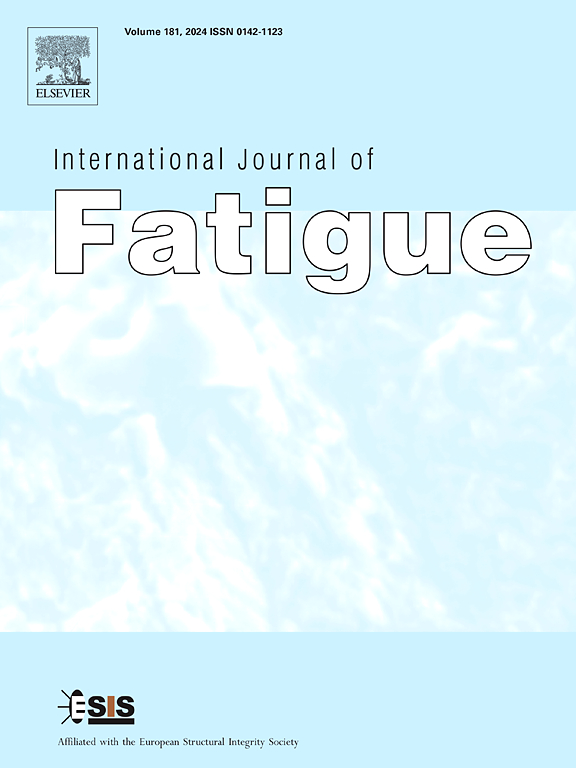高周疲劳状态下应力诱发马氏体相变裂纹表面接触行为的数值模拟
IF 5.7
2区 材料科学
Q1 ENGINEERING, MECHANICAL
引用次数: 0
摘要
建立了应力诱发马氏体相变状态的修正动力学模型,并通过AISI 348不锈钢的实验数据验证了所建立的本构控制方程的可靠性。然后,基于建立的含马氏体相变的本构控制方程,对金属材料在甚高周疲劳(VHCF)过程中,细粒区(FGA)裂纹表面接触作用导致的微观组织细化和纳米晶粒形成过程进行了数值模拟。当应力比为- 1、- 0.5、0.1和0.3时,数值模型计算的最大接触应力与实验中观察到的FGA厚度之间存在相关性。模拟结果很好地符合了初始裂纹表面之间多次循环挤压(NCP)导致初始裂纹尾迹晶粒细化的形成机理,从而诱发了高强度合金中FGA的形成。本文章由计算机程序翻译,如有差异,请以英文原文为准。
Numerical simulation of crack surface contacting behavior with stress-induced martensitic phase transformation in very-high-cycle fatigue regime
A modified kinetic model for the status of stress-induced martensitic phase transformation is developed, and the reliability of the resultant constitutive governing equations is verified by the experimental data of stainless steel AISI 348. Then, a numerical simulation, based on the established constitutive governing equations with martensitic phase transformation, is performed to address the process of microstructure refinement and nanograin formation due to the contact actions at crack surfaces in fine-granular-area (FGA) region in very-high-cycle fatigue (VHCF) process of metallic materials. A correlation between the calculated maximum contact stresses from the numerical model and the observed FGA thickness in experiments is confirmed for the stress ratios of −1, −0.5, 0.1 and 0.3 for a high-strength steel. The simulation results conform well to the FGA formation mechanism of numerous cyclic pressing (NCP) between originated crack surfaces, which causes grain refinement at originated crack wake and therefore induces the formation of FGA in high-strength alloys.
求助全文
通过发布文献求助,成功后即可免费获取论文全文。
去求助
来源期刊

International Journal of Fatigue
工程技术-材料科学:综合
CiteScore
10.70
自引率
21.70%
发文量
619
审稿时长
58 days
期刊介绍:
Typical subjects discussed in International Journal of Fatigue address:
Novel fatigue testing and characterization methods (new kinds of fatigue tests, critical evaluation of existing methods, in situ measurement of fatigue degradation, non-contact field measurements)
Multiaxial fatigue and complex loading effects of materials and structures, exploring state-of-the-art concepts in degradation under cyclic loading
Fatigue in the very high cycle regime, including failure mode transitions from surface to subsurface, effects of surface treatment, processing, and loading conditions
Modeling (including degradation processes and related driving forces, multiscale/multi-resolution methods, computational hierarchical and concurrent methods for coupled component and material responses, novel methods for notch root analysis, fracture mechanics, damage mechanics, crack growth kinetics, life prediction and durability, and prediction of stochastic fatigue behavior reflecting microstructure and service conditions)
Models for early stages of fatigue crack formation and growth that explicitly consider microstructure and relevant materials science aspects
Understanding the influence or manufacturing and processing route on fatigue degradation, and embedding this understanding in more predictive schemes for mitigation and design against fatigue
Prognosis and damage state awareness (including sensors, monitoring, methodology, interactive control, accelerated methods, data interpretation)
Applications of technologies associated with fatigue and their implications for structural integrity and reliability. This includes issues related to design, operation and maintenance, i.e., life cycle engineering
Smart materials and structures that can sense and mitigate fatigue degradation
Fatigue of devices and structures at small scales, including effects of process route and surfaces/interfaces.
 求助内容:
求助内容: 应助结果提醒方式:
应助结果提醒方式:


